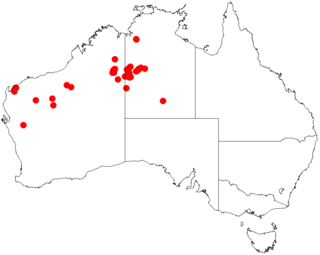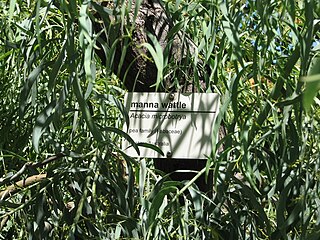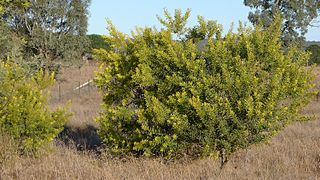
Acacia papyrocarpa, commonly known as western myall, is a tree in the family Fabaceae native to arid areas of central and western Australia.

Acacia fimbriata, commonly known as the fringed wattle, Brisbane golden wattle, or just the Brisbane wattle, is a species of Acacia that is native to much of the east coast of Australia. It is one of the floral emblems of the city of Brisbane, Queensland.

Acacia neriifolia, also known as the oleander wattle, silver wattle or pechy wattle, is a tree in the genus Acacia native to north eastern Australia. It is common in the Moonbi Ranges.

Acacia stenophylla, commonly referred to as the shoestring acacia, is an evergreen tree in the family Fabaceae and native to Australia. It is not considered rare or endangered.

Acacia prominens is a shrub or tree in the genus Acacia native to New South Wales, Australia.

Acacia flavescens, also known as the red wattle, yellow wattle or primrose ball wattle, is a tree in the genus Acacia native to eastern Australia.

Acacia pachycarpa is a tree or shrub belonging to the genus Acacia and the subgenus Juliflorae that is endemic to central and western parts of northern Australia.

Acacia paraneura, commonly known as weeping mulga, is a tree or shrub belonging to the genus Acacia and the subgenus Juliflorae. It is native to arid regions of Australia. The Indigenous Kurrama peoples know the tree as warlun.

Acacia daphnifolia, also known as northern manna gum, is a tree or shrub belonging to the genus Acacia and the subgenus Phyllodineae that is endemic to Western Australia.

Acacia microbotrya, commonly known as manna wattle or gum wattle, is a shrub or tree belonging to the genus Acacia and the subgenus Phyllodineae that is native to Western Australia.

Acacia calcicola is a shrub or tree of the genus Acacia and the subgenus Plurinerves that is native to parts of central Australia. Common names for this species include; shrubby wattle, shrubby mulga, myall-gidgee, northern myall and grey myall. Indigenous Australians the Pitjantjatjara peoples know the tree as ikatuka, the Warlpiri know it as jirlarti and the Arrernte know it as irrakwetye.

Acacia multisiliqua is a shrub or tree of the genus Acacia and the subgenus Plurinerves that is endemic to northern Australia.

Acacia oswaldii, commonly known as boree, umbrella wattle, umbrella bush, whyacka, middia, miljee, nelia and curly yarran, is a shrub or tree of the genus Acacia and the subgenus Plurinerves.

Acacia rubida, commonly known as red stem wattle, red stemmed wattle or red leaved wattle, is a shrub belonging to the genus Acacia and the subgenus Phyllodineae that is native to parts of eastern Australia.

Acacia provincialis, commonly known as swamp wattle or wirilda or water wattle or perennial wattle, is a tree or shrub belonging to the genus Acacia and the subgenus Phyllodineae native to southern and south eastern Australia.

Acacia sertiformis, commonly known as curly-leaved wattle, is a shrub belonging to the genus Acacia and the subgenus Phyllodineae native to north eastern Australia.

Acacia siculiformis, commonly known as dagger wattle, is a shrub belonging to the genus Acacia and the subgenus Phyllodineae native to south eastern Australia.

Acacia doratoxylon, commonly known as currawang, lancewood, spearwood or coast myall, is a shrub or tree belonging to the genus Acacia and the subgenus Juliflorae that is native to eastern and south eastern Australia.

Acacia excelsa, also known as ironwood, rosewood, bunkerman and doodlallie is a tree of the genus Acacia and the subgenus Plurinerves that is endemic to inland parts of north-eastern Australia. In the Gamilaraay language it is known as dhan, gayan or gan.

Acacia subporosa, also commonly known as river wattle, bower wattle, narrow-leaf bower wattle and sticky bower wattle, is a tree or shrub of the genus Acacia and the subgenus Plurinerves that is endemic to an area of south eastern Australia. It is considered to be rare in Victoria






















